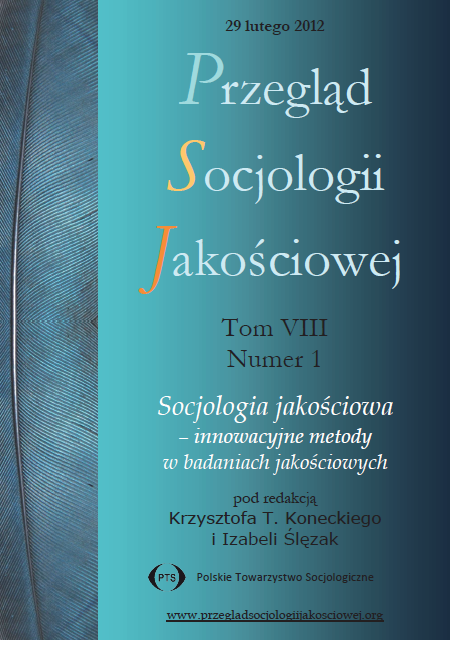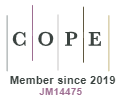Watching thousand images at once. Content analysis toolkit in the photo-driven research project “The Invisible City”
DOI:
https://doi.org/10.18778/1733-8069.8.1.03Keywords:
visual sociology, photography, image content analysis, coding sheet, saturation of categories, ethnography of the research process, “The Invisible City”, everyday urbanismAbstract
Regardless of the growing popularity of visual studies, the subject of the tools for image content analysis particularly employed in the non-critical paradigms to categorize large amounts of data and allow triangulation between the qualitative and the quantitative techniques is nearly absent in Polish sociological writings. The main goal of this article is to at least partially fill this gap. The author pursues this objective through the adoption of a broad perspective for the discussion of the manner in which the coding sheet has been designed and used in a research project “The Invisible City.” Illustrating the point with the chosen example, he follows the rules in the sheet construction and operation, and also seeks them in a photographing scenario, the initial categorization of data, and sampling. Also, he analysis the aims and the consequences of a non-institutional forms of space modification in a large Polish cities and the methodological dilemmas of studying the subject with a visual means.
Downloads
References
Berger John (2008) Sposoby widzenia. Przełożył Mariusz Bryl. Warszawa: Alatheia.
Google Scholar
Britton Paul (2010) Profil mordercy. Przełożył Przemysław Kiliński. Kraków: Znak.
Google Scholar
Charmaz Kathy (2009) Teoria Ugruntowana. Praktyczny przewodnik po analizie jakościowej. Przełożyła Barbara Komorowska. Warszawa: Wydawnictwo Naukowe PWN.
Google Scholar
Frąckowiak Maciej i in. (2010) Spacer po „Niewidzialnym Mieście”, [dostęp 2 listopada 2010]. Dostępny w Internecie: http://kuratorart.pl/amm/wp-content/uploads/2010/10/spacer-po-niewidzialnym-miescie.pdf
Google Scholar
Grady John (2007) Advertising images as social indicators: depictions of blacks in LIFE Magazine, 1936–2000. „Visual Studies”, vol. 22, no. 3, s. 211–239.
Google Scholar
DOI: https://doi.org/10.1080/14725860701657134
Houck Max M. (2007) Forensic science. Modern methods in solving crime. Westport: Praeger.
Google Scholar
Knowles Caroline, Sweetman Paul, red., (2004) Picturing the Social Landscape. Visual Methods and the Sociological Imagination. London: Routledge.
Google Scholar
DOI: https://doi.org/10.4324/9780203694527
Konecki Krzysztof T. (2005) Wizualne wyobrażenia. Główne strategie badawcze w socjologii wizualnej a metodologia teorii ugruntowanej. „Przegląd Socjologii Jakościowej”, t. 1, nr 1 [dostęp 2 listopada 2010]. Dostępny w Internecie: http://www.qualitativesociologyreview.org/PL/archive_pl.php
Google Scholar
DOI: https://doi.org/10.18778/1733-8069.1.1.04
Konecki Krzysztof T. (2010) Wizualna Teoria Ugruntowana. Nauczanie teorii ugruntowanej przy pomocy obrazów i analizy wizualnej. „Przegląd Socjologii Jakościowej”, t. 6, nr 2 [dostęp 2 listopada 2010]. Dostępny w Internecie: http://www.qualitativesociologyreview.org/PL/archive_pl.php
Google Scholar
DOI: https://doi.org/10.18778/1733-8069.6.2.01
Krajewski Marek (2006) Niewidzialne Miasto. Analiza pozainstytucjonalnych form społecznej aktywności [w:] Marek Nowak, Michał Nowosielski, red., Czy społeczny bezruch? O społeczeństwie obywatelskim i aktywności we współczesnej Polsce. Poznań: Instytut Zachodni, s. 193–203.
Google Scholar
Krajewski Marek (2010) Raport z analizy zdjęć zgromadzonych w bazie Niewidzialne Miasto [dostęp 2 listopada 2010]. Dostępny w Internecie: http://nw2.10sa.com/wp-content/uploads/2010/10/Raport-z-analizy-zdj%C4%99%C4%87-zgromadzonych-w-bazie-Niewidzialne-miasto.pdf
Google Scholar
Krajewski Marek, Olszewski Lechosław (2008) Animator w Mieście, czyli Niewidzialne Miasto [dostęp 2 listopada 2010]. Dostępny w Internecie: http://nmbadania.info/wp-content/uploads/2010/10/Amator-wmiescie-czyli-Niewidzialne-Miasto-2008.pdf
Google Scholar
Kvale Steinar (2004) InterViews. Wprowadzenie do jakościowego wywiadu badawczego. Przełożył Stanisław Zabielski. Białystok: Trans Humana.
Google Scholar
Latour Bruno (1990) Visualisation and cognition. Drawing things together [w:] Michael Lynch, Steve Woolgar red., Representation in Scientific Practice. Cambridge–London: The MIT Press, s. 19–68.
Google Scholar
Lutz Catherine, Collins Jane L. (1993) Reading National Geographic. Chicago: University of Chicago Press.
Google Scholar
Łączyńska Ewa (2008) Nie-widzialne miasto, c.d. „Obieg”, 1 grudnia 2008 [dostęp 2 listopada 2010]. Dostępny w Internecie: http://www.obieg.pl/print/4610
Google Scholar
Podgórski Michał (2008) Portrety zaginionych. Reformatowanie społecznego doświadczania miasta. „Czas Kultury”, nr 1, s. 72–81.
Google Scholar
Podgórski Michał, Rogowski Łukasz (2008) Niewidzialne Miasto [w:] Tadeusz Wieczorek, red., 7 Warsztaty Twórczego Niepokoju Kieszeń Vincenta. Poznań: Centrum Sztuki Dziecka, strony nienumerowane.
Google Scholar
Rose Gillian (2010) Interpretacja materiałów wizualnych. Krytyczna metodologia badań nad wizualnością. Przełożyła Ewa Klekot. Warszawa: PWN.
Google Scholar
Suchar Charles (1997) Grounding Visual Research In Shooting Scripts. „Qualitative Sociology”, vol. 20, no. 1, s. 33–55.
Google Scholar
DOI: https://doi.org/10.1023/A:1024712230783
Thorwald Jürgen (2009) Stulecie detektywów. Przełożyli Karol Bunsch i Wanda Kragen. Kraków: Znak.
Google Scholar
Tufte Edward (1997) Visual Explanations: Images and Quantities. Evidence and Narrative. Ceshire: Graphic Press.
Google Scholar
DOI: https://doi.org/10.1063/1.168637
Wright Terence (1999) The Photography Handbook. New York: Routledge.
Google Scholar
Downloads
Published
How to Cite
Issue
Section
License

This work is licensed under a Creative Commons Attribution-NonCommercial-NoDerivatives 4.0 International License.














